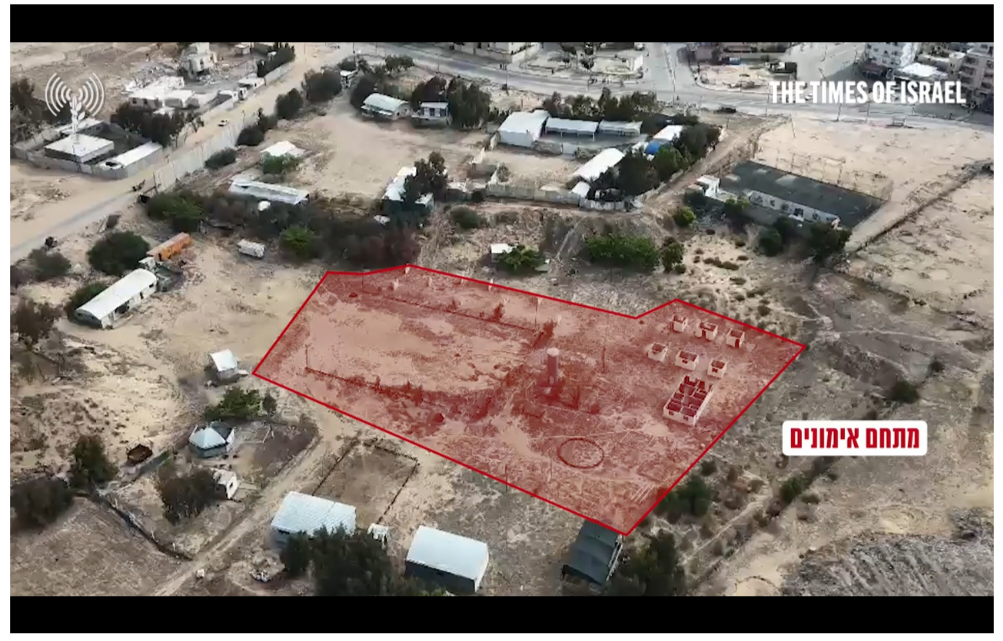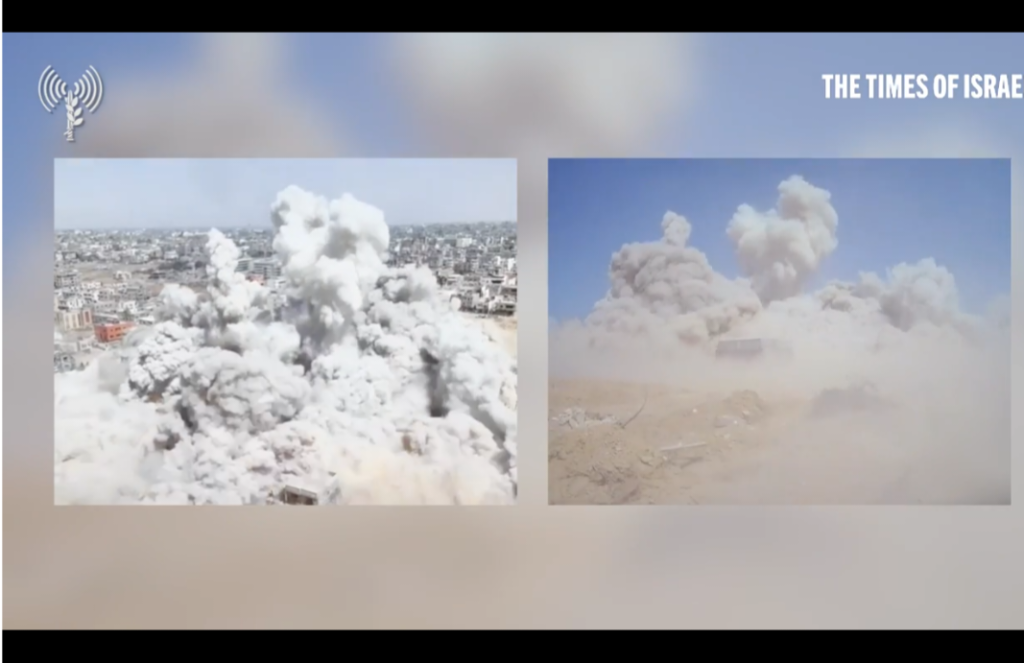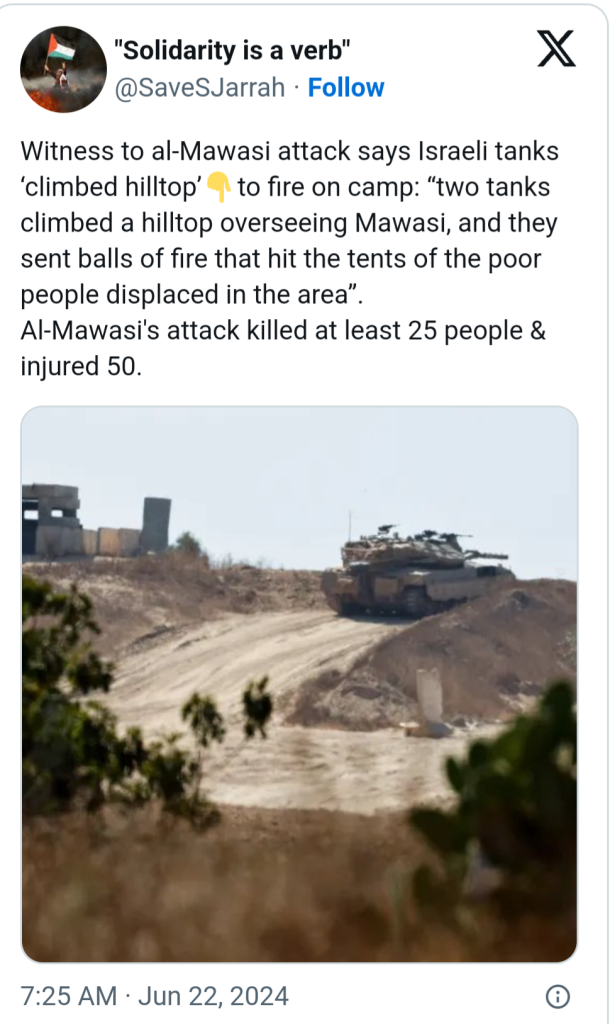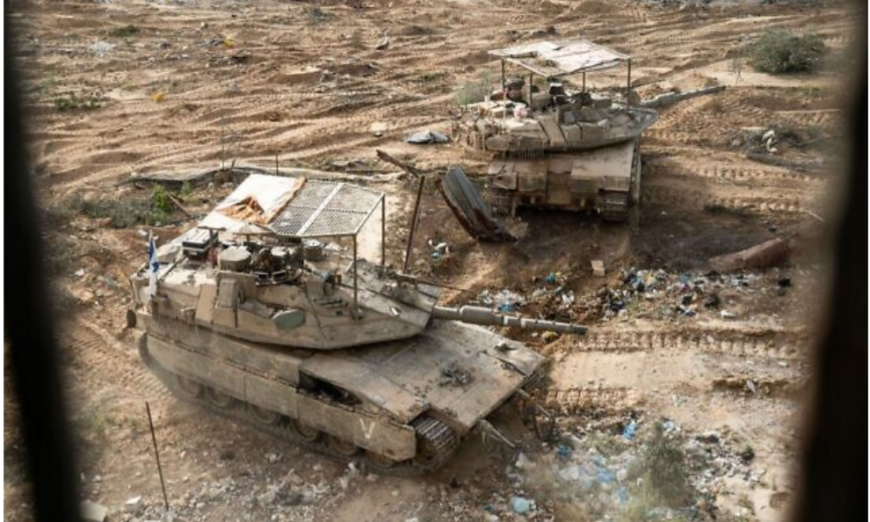Troops of the 401st Armored Brigade operate in southern Gaza’s Rafah, in a handout photo published June 23, 2024. (Israel Defense Forces.)
Strikes target terror infrastructure across Strip, as IDF tanks said sighted near ‘humanitarian zone’; IAF confirms targeting Hamas, PIJ operatives at site previously used by UNRWA.
Troops raided and demolished a Hamas training complex in the Tel Sultan neighborhood of Rafah in southern Gaza, the Israel Defense Forces said Sunday, as Israeli tanks were said to approach the nearby “humanitarian zone” of al-Mawasi, amid indications Jerusalem was seeking to arrange for the Strip’s post-war governance.
The so-called Abu Said outpost, belonging to Hamas’s Tel Sultan Battalion, was captured by the 401st Armored Brigade. The IDF said troops at the base located the office of the Tel Sultan Battalion’s commander, Mahmoud Hamdan, as well as a weapons depot and several tunnel shafts, which the army said it would investigate.
Elsewhere in the outpost, the IDF said it had raided the office of Yasser Natat, a Hamas commander responsible for the Rafah Brigade’s rocket fire on Israel and troops in Gaza. Soldiers from the 401st Brigade also launched an assault on a separate training site in the area, where weapons, additional tunnels, and intelligence materials were found, the military added.
The raids came as the IDF said early Sunday it had carried out dozens of airstrikes on terrorist infrastructure in the Gaza Strip over the past day. However, the army did not provide an update on a Saturday strike on Gaza City that reportedly targeted senior Hamas official Raad Saad.
Also Sunday, the military said that the Israel Air Force struck a site where Hamas and Palestinian Islamic Jihad operatives were gathered that was previously part of UNRWA’s headquarters in Gaza City.
The IDF said it carried out aerial surveillance ahead of the strike carried out by fighter jets, used a “precision munition” and used various intelligence, to prevent harm to civilians.
“This is another example of Hamas’ systematic exploitation of civilian infrastructure and the civilian population as a human shield for its terrorist activities,” the IDF said in a statement.
According to Palestinian media, at least five people were killed in the strike.
According to the Strip’s health ministry, over 37,000 Palestinians have been killed in the Strip since the terror group stormed southern Israel, murdering some 1,200 people and taking 251 hostages, sparking the Gaza war. The Hamas-led ministry’s figures, which cannot be verified, do not distinguish between civilians and combatants, of whom the IDF says it has killed some 15,000 in the Strip, along with 1,000 terrorists the army says it killed in Israel on October 7.
Amid the Sunday airstrikes, ground troops continued to operate in central Gaza’s Netzarim Corridor and Rafah in the south.
The military maneuvers in Rafah have emerged as a sticking point in Israel’s relations with its key ally, the United States. President Joe Biden in early May withheld a shipment of arms to Israel over fears they would be used against the large number of civilians who had sought shelter in the Strip’s southernmost city.
Israel maintains the Rafah offensive is necessary to dismantle four remaining Hamas battalions. Last week, the military said it had dismantled about half of Hamas’s fighting force in Rafah, killing at least 550 gunmen in the area.
Over a million Palestinians sought shelter in Rafah after being displaced from the Strip’s north and center since the war began. On the IDF’s orders, the vast majority of the city’s population has in the past two months evacuated to the designated humanitarian zone of al-Mawasi, northwest of Rafah.
Reuters reported on Sunday that locals said Israeli tanks had advanced to the edge of the displaced persons’ camp.


Images of two Israeli tanks stationed on a hilltop overlooking the coastal area went viral on social media, but could not be independently verified. According to Reuters, residents said that IDF tanks had pushed deeper into western and northern Rafah in recent days.
Gallant leaves for Washington amid US-Israel tensions.
Defense Minister Yoav Gallant indicated on Sunday that Israel was preparing for the war’s third and final phase, which he had in October defined as “the creation of a new security regime in the Gaza Strip [and] the removal of Israel’s responsibility for day-to-day life in the Gaza Strip.”
“The transition to ‘Phase three’ in Gaza is of great importance,” Gallant said on Sunday before alighting a plane to Washington, where he is expected to meet with US Secretary of State Antony Blinken, Defense Secretary Lloyd Austin, CIA Director William Burns and Special Envoy Amos Hochstein.
“I will discuss this transition with US officials, touching on how it may enable additional things [to take place], and I know that we will achieve close cooperation with the US on this issue as well,” Gallant said.
In a May speech, Gallant made public his disagreement with Prime Minister Benjamin Netanyahu over an arrangement for Gaza once the war ends. While Netanyahu rejects any role for the Palestinian Authority in the Strip’s post-war government, Gallant said Israel has no other alternative.
The military, meanwhile, has indicated over the past week that it considers unattainable Netanyahu’s stated goal of completely vanquishing Hamas, drawing a rebuke from the premier.
The defense minister’s trip comes as White House officials have expressed outrage at Netanyahu’s allegation in a Tuesday video that the US was withholding arms shipments from Israel, which the Biden administration denies. Netanyahu doubled down on the claim at a weekly cabinet meeting on Sunday.
Gallant also said he would discuss with his US counterparts escalating tensions on Israel’s northern border, where fighting has raged for months between the IDF and Lebanon’s Hezbollah. Israel and its allies consider the prospect of a full-blown war with the Iran-backed terror group to be increasingly likely.
The White House has reportedly assured Israel of full US support in such an event.
Haaretz on Sunday quoted an an Israeli official as saying that Jerusalem believes the potential war with Hezbollah was leading Yahya Sinwar, Hamas’s military chief in Gaza, to stall on talks mediated by the US, Qatar and Egypt, to secure a truce and hostage release deal between Israel and the Palestinian terror group.
“Hamas doesn’t want a deal now,” the source said, according to Haaretz. “It doesn’t want to release the hostages, but rather to play for time. Yahya Sinwar… wants war to erupt in the northern border and therefore will not move toward a ceasefire.”
It is believed that 116 hostages abducted by Hamas on October 7 remain in Gaza — not all of them alive — after 105 civilians were released from Hamas captivity during a weeklong truce in late November, and four hostages were released prior to that. Seven hostages have been rescued by troops alive, and the bodies of 19 hostages have also been recovered, including three mistakenly killed by the military.
The IDF has confirmed the deaths of 41 of those still held by Hamas, citing new intelligence and findings obtained by troops operating in Gaza.
One more person is listed as missing since October 7, and their fate is still unknown.
Hamas is also holding two Israeli civilians who entered the Strip in 2014 and 2015, as well as the bodies of two IDF soldiers who were killed in 2014.


